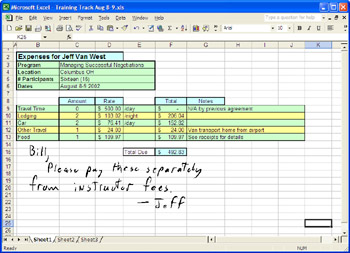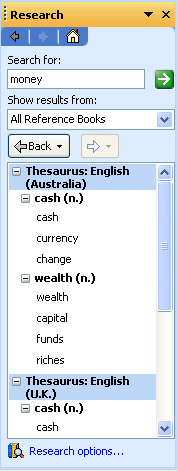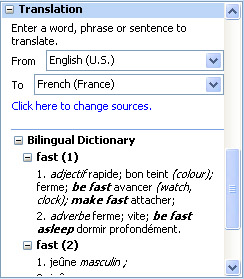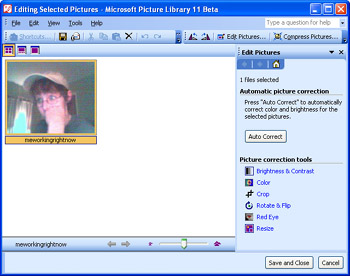Chapter 8: Microsoft Office 2003 Productivity Enhancements
|
|
Up to this point in the book, we've focused on the new features, tools, and technologies in Microsoft Office 2003. But this release includes more than great new features-it also offers many productivity enhancements in each of the core applications, as well as additions to Office as a whole. This chapter gives you a quick look at the wide range of improvements that can make your work easier, more productive, more secure, and more flexible.
Office-Wide Enhancements
A number of new and enhanced productivity features are available in various Office 2003 applications. They include improved ways to enter, protect, and share data as well as tools for adding sound, pictures, and scanned data to your current applications.
Using Ink
Most people grumble about their handwriting but still prefer jotting notes on a pad of paper over typing them in Word. What if you could do both? Imagine sitting in a meeting or a coffee shop, scribbling notes on a Tablet PC (or the graphics tablet attached to your desktop computer), and watching your doodles become data.
Ink enhancements in Office 2003 make handwriting a viable option for entering and working with text, numbers, and slides in Microsoft Office Word, Excel, and PowerPoint 2003. Now Tablet PC users can write information and allow the application to transform the data to typed text or preserve the writing as handwriting. The Write Anywhere feature allows you to turn most of your Tablet PC into a writing surface. This means you're not limited to the Input Panel that appears at the bottom of your tablet in portrait mode. You can customize the ink feature by making these changes to Write Anywhere:
-
Adding the Write Anywhere button to the title bar
-
Changing the color and thickness of your writing
-
Modifying the 'wait time' between when you write or draw and when the input is displayed
Word automatically converts handwriting to typed text, but you can elect to leave your notes handwritten if you like. To do this, simply enter your text in the Writing Pad of the Input Panel and then click the down-arrow to the right of the Send button. From the displayed list, click Send as Ink. The data is placed in the document at the cursor position, but your handwriting rather than typed text appears.
| Note | The Send as Ink feature works as a toggle, so Word will continue inputting your handwriting as ink until you choose Send as Text. |
Inking Modes
When you use Ink on the Tablet PC, you'll notice three new toolbars:
-
Ink Annotations turns on the annotations feature so that you can add notes on documents, slides, or spreadsheets. A toolbar provides tools for choosing line color and thickness, using an eraser, selecting objects, or stopping annotations.
-
Ink Comments enables the Input Panel or the Write Anywhere feature so that you can add comments directly into the document at the cursor position. A toolbar with only two options-Draw Ink and Erase Ink-appears when you choose Ink Comments.
-
Ink Drawing And Writing displays the Drawing Canvas (and accompanying toolbar) so that you can write or draw a diagram directly into your document. You also can change ink color and thickness and erase ink as needed.
Bubble Comments in Microsoft Office Word 2003
Comment bubbles were a new addition to Word 2002, enabling users to view and respond to comments (in Print Layout and Web Layout views) in bubbles in the right margin of the document. The ink feature in Office 2003 allows you to use Word's bubble comments feature and also provides for handwritten and drawn comments inside the bubbles. This enables you to insert traditional comments using a variety of handwritten, typed, or mixed formats. (See Figure 8-1.)

Figure 8-1: You can enter bubble comments in Word with a mix of hand written, drawn, or typed notes.
| Tip | Using comments in this way has advantages over using annotations if several reviewers are commenting on a document. Comments can be tracked, hidden, or organized by reviewer, whereas annotations can be only hidden or displayed. |
Cell-Centric Comments in Microsoft Office Excel 2003
In Office 2003, ink annotations you add to your Excel spreadsheets are anchored to the cell that was selected when you created the ink note. This means that no matter how the worksheet might change-cutting and pasting an annotated range from one worksheet to another, inserting or removing columns, and so on-the annotation stays with the cell it is linked to. (See Figure 8-2.)

Figure 8-2: Ink annotations in Excel are linked to the cell that was selected when they were created.
Microsoft Office PowerPoint 2003 Annotations
Ink might seem like an intuitive feature in PowerPoint; in fact, the Pen option has been around in PowerPoint for several generations. Ink is helpful in presentations for drawing circles and arrows on slides; and it can be a dramatic addition to a slide showing a table, diagram, or chart. In fact, in PowerPoint 2003, you can create entirely hand-drawn slides, if that meets your presentation needs.
Ink in Microsoft Office Outlook 2003
Finally, ink in Outlook enables you to write out your e-mail messages long hand, draw maps to the downtown bookstore, sign your name with a real signature, or make notes on an e-mail message you're forwarding. Additionally, you can write out your to do list, add the items to your task view, and create Calendar entries using ink.
Internet Faxing
Office 2003 builds in the option of using an Internet service to send a fax from within Word, Excel, or PowerPoint. Relying on partnerships in the Microsoft Office Marketplace, Office enables you to choose Sent to in the File menu and select the new Fax Service option. (See Figure 8-3.)

Figure 8-3: Internet fax capability is now built into Word, Excel, and PowerPoint.
The first time you choose the Fax Service option, a prompt lets you know that you need to sign up for an Internet fax service. When you click OK, you are taken to the Office Marketplace Web site, where you can choose a fax service provider. After that, you'll be able to send and receive faxes automatically while you work in your favorite applications.
IRM (Information Rights Management)
IRM technology is a new addition to Office 2003 that enables you to limit others' accessibility to your critical business documents. IRM actually protects the document at a file level (as opposed to the network level), giving users controls that can allow or disable features that could be used to forward materials to people outside the organization or change valuable data that shouldn't be modified.
Here's a quick look at some of the key features of IRM:
-
A document-protection model that works at the file level.
-
Features for protected documents can be disabled to block forwarding, e-mailing, faxing, printing, or editing.
-
Users can set expiration dates for documents so that they will not be viewable past a certain date.
-
Microsoft offers an IRM Viewer free of charge to organizations receiving IRM-protected documents that do not currently use Office 2003.
-
IRM requires Windows .NET Server and a premium Client Access License.
All businesses have sensitive data that they want to ensure stays within the limits of the organization. Payroll information, private personnel data, critical strategic information, specifications for new products, and valuable market research are just a few of the documents organizations want to keep a handle on. By using the IRM features in Office 2003, organizations can limit how far a document can travel and control what can be done with it. For example, the forwarding, copying, and printing features might be disabled for a sensitive e-mail message; attached documents are similarly protected.
In Word and Excel, users are assigned various roles, depending on the level of permission they are granted in a specific document. A Viewer can view files as read-only and cannot make any modifications; Reviewer enables a user to make comments in a file and add information; Editor grants editing privileges so that the file can be modified.
| Tip | This assignment of roles is a feature IRM has in common with SharePoint Team Services, which enables you to grant various levels of access to SharePoint Team Services sites by choosing Reader, Contributor, Web Designer, or Administrator roles for team members. |
Research Task Pane
The new Research task pane is another sophisticated feature in Office 2003 that enables information workers to bring additional resources to their current applications. The Research task pane enables users to search for information on the company intranet, over the Internet, or in a variety of sources both inside and outside their regular applications. This enables them to find the information they need-a word, a definition, a translation-on the fly, without stopping work in their current document.
Built into the Research task pane is an extensive Research Library that houses a number of resources, including a multilanguage thesaurus and dictionaries, an automatic translation utility, and an Internet encyclopedia. Users can also subscribe to third-party resource providers, which can be added to the Research options and searched automatically.
Users can display the task pane in the usual way-by choosing View, Task Pane and then selecting Research from the drop-down list in the upper-right corner of the task bar, but there's also a more intuitive way. When a user wants to find out more about a specific word, the user can hold the Alt key and click the word; the Research utility does a quick search and displays alternate definitions (as well as antonyms, synonyms, and more) in the Research task pane. (See Figure 8-4, on the next page.)

Figure 8-4: The Research task pane searches the Research Library sources and displays options for the selected word.
Mark Dodge, coauthor of Microsoft Office Excel 2003 Inside Out (Microsoft Press, 2003), says: 'I think one of the coolest things in Office-and it's not an often talked-about feature-is the translation capability. You can enter a word and get a translation immediately in any language you select.' The Translation feature is available when you scroll through the resources in the Research task pane.

Picture Library
The new Microsoft Picture Library gives you image-editing tools when you work with Picture Libraries on SharePoint Team Services sites. When you or your team members create picture libraries, you can upload images from your local hard drives or network drives; import images from digital cameras or scanners; and post images to the team site.
When you click an image in a picture library and then click the Edit Picture tool, the Microsoft Picture Library opens. (See Figure 8-5.) This utility enables you to perform basic image-editing functions on the selected picture. These editing possibilities include the following:
-
Change brightness and contrast
-
Alter the color of the picture
-
Crop the image
-
Rotate and flip the image
-
Remove red eye in the photo
-
Resize the picture

Figure 8-5: The Microsoft Picture Library is a new tool in Office 2003 that enables you to edit your pictures.Tip The easiest modification is the one to try first: click AutoCorrect to cause the Picture Library to correct the color and brightness of the selected image for the best possible display.
You can also use the Microsoft Picture Library to print pictures; export images to other file formats; e-mail pictures to friends and coworkers; compress images; and work with images in groups for export, conversion, or print processes.
|
|
EAN: 2147483647
Pages: 101